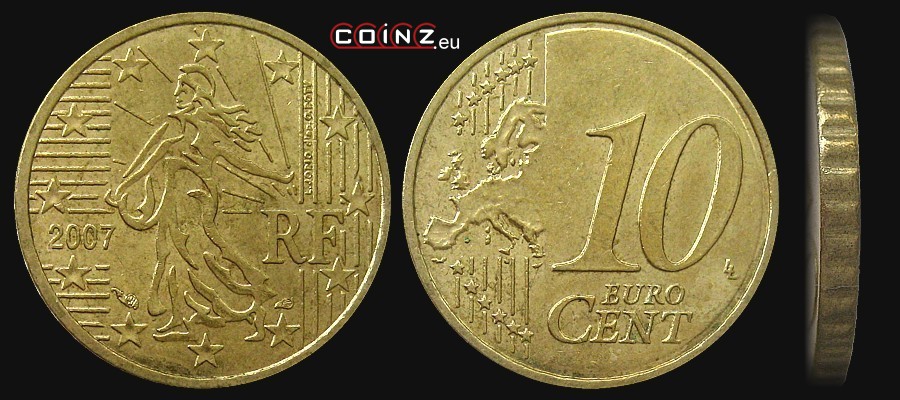10 euro cent FRANCE (od 2007)


| diameter: | weight: | thickness: | alloy: |
| 19.75 mm | 4.1 g | 1.93 mm | Cu89Al5Zn5Sn1 (Nordic Gold) |
obverse:
in coin centre personification of France - simplified figure of Marianne in Phrygian cap sowing cereal leftwards (La Semeuse), in the background the Sun hidden mostly below the horizon; on the right letters: RF (RÉPUBLIQUE FRANÇAISE - French Republic); on the left year of issue; at the edge a ring of twelve five-pointed stars - symbol of the European Union
reverse:
edge:
reeded
issue date:
1 I 2007
withdrawal date:
in circulation
designer:
Laurent Jorio based on the design of Loius Oscar Roty (vertically over RF in the obverse signature L.JORIO D'AP.O.ROTY - D'APRÉS OSCAR ROTY - based on Oscar Roty), Luc Luycx (initials LL after 10 in the reverse)
mint:
 La Monnaie de Paris (The Paris Mint), Pessac (mint mark before the Marianne's feet in the obverse, after Marianne's feet privy mark of mint's director Hubert Larivière - horn - in years 2007-2010, or Yves Sampo - rosette - from 2011)
La Monnaie de Paris (The Paris Mint), Pessac (mint mark before the Marianne's feet in the obverse, after Marianne's feet privy mark of mint's director Hubert Larivière - horn - in years 2007-2010, or Yves Sampo - rosette - from 2011)

mintage:
| 2007 | 90 095 800 | horn | + 60 000 in annual boxed sets |
| 2008 | 178 706 400 | horn | + 60 000 in annual boxed sets |
| 2009 | 142 710 000 | horn | + 60 000 in annual boxed sets |
| 2010 | 76 000 000 | horn | + 55 500 in annual boxed sets |
| 2011 | 100 000 000 | rosette | + 45 500 in annual boxed sets |
| 2012 | 77 000 000 | rosette | + 42 000 in annual boxed sets |
| 2013 | 135 000 000 | rosette | + 28 000 in annual boxed sets |
| 2014 | 35 000 000 | rosette | + 28 000 in annual boxed sets |
| 2015 | 71 000 000 | rosette | + 28 000 in annual boxed sets |
mint marks:
interesting facts:
last update: 12 VIII 2015
coins catalogue :: katalog monet :: münzkatalog :: catalogue de monnaies :: catálogo de monedas :: catalogo monete :: каталог монет :: κέρματα κατάλογος :: COINZ.eu
© 2010-2025 :: Adam Kubicki :: COINZ.eu :: All rights reserved.


